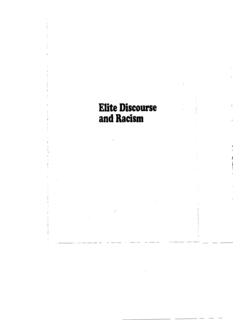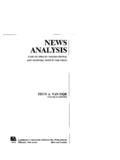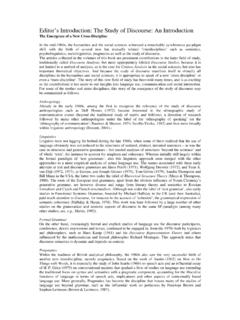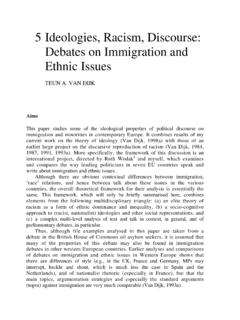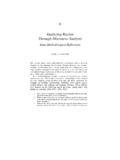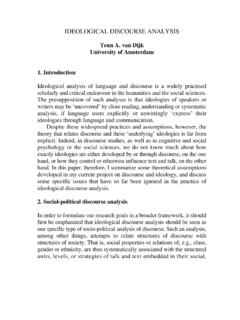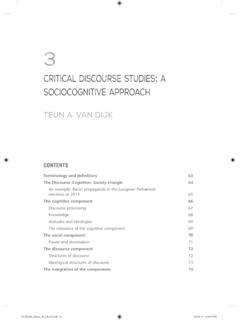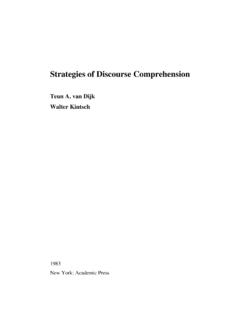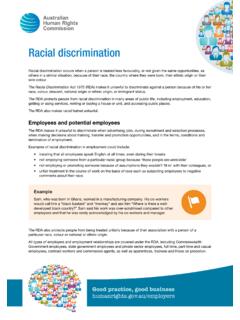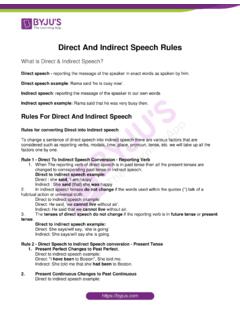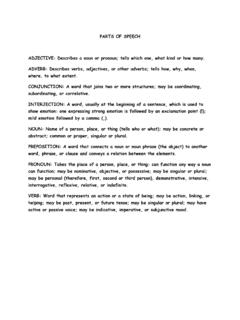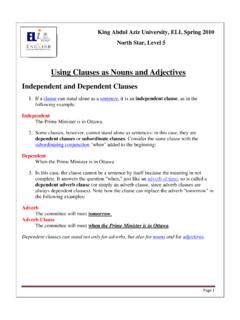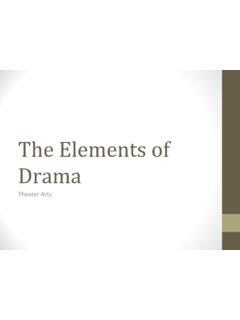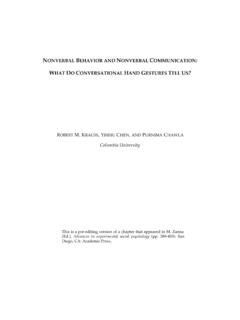Transcription of 22 CriticalDiscourseAnalysis - Teun A. van Dijk
1 JWST555-22 JWST555-TannenJanuary 16, 201517:43 Printer Name: Yet to ComeTrim: 244mm 170mmUNCORRECTED PROOFS22 Critical Discourse AnalysisTEUN A. VAN DIJK0 Introduction: What Is Critical Discourse Analysis?Critical Discourse Analysis (CDA) is discourse analytical research that primarily stud-ies the way social-power abuse and inequality are enacted, reproduced, legitimated,and resisted by text and talk in the social and political context. With suchdissidentresearch, critical discourse analysts take an explicit position and thus want to under-stand, expose, and ultimately challenge social inequality.
2 This is also why CDA may becharacterized as asocial movementof politically committed discourse widespread misunderstanding of CDA is that it is a specialmethodof doing dis-course analysis. There is no such method: in CDA all methods of the cross-disciplineof discourse studies, as well as other relevant methods in the humanities and socialsciences, may be used (Wodak and Meyer 2008; Titscheret al. 2000). To avoid this mis-understanding and to emphasize that many methods and approaches may be used inthe critical study of text and talk, we now prefer the more general termcritical discoursestudies(CDS) for the field of research (van Dijk 2008b).
3 However, since most studies con-tinue to use the well-known abbreviation CDA, this chapter will also continue to use ananalytical practice, CDA is not one direction of research among many others inthe study of discourse. Rather, it is a criticalperspectivethat may be found in all areas ofdiscourse studies, such as discourse grammar, Conversation Analysis, discourse prag-matics, rhetoric, stylistics, narrative analysis, argumentation analysis, multimodal dis-course analysis and social semiotics, sociolinguistics, and ethnography of communica-tion or the psychology of discourse-processing, among others.
4 In other words, CDA isdiscourse studywith an of the tenets of CDA could already be found in the critical theory of theFrankfurt School before World War II (Agger 1992b; Drake 2009; Rasmussen andSwindal 2004). Its current focus on language and discourse was initiated with theThe Handbook of Discourse Analysis, Second by Deborah Tannen, Heidi E. Hamilton, and Deborah Schiffrin. 2015 John Wiley & Sons, Inc. Published 2015 by John Wiley & Sons, 16, 201517:43 Printer Name: Yet to ComeTrim: 244mm 170mmUNCORRECTED PROOFSC ritical Discourse Analysis467critical linguisticsthat emerged (mostly in the United Kingdom and Australia) at theend of the 1970s (Fowleret al.)
5 1979; see also Mey 1985). CDA also has counterpartsin critical developments in sociolinguistics, stylistics, pragmatics, psychology, andthe social sciences, some already dating back to the early 1970s (Birnbaum 1971;Calhoun 1995; Fay 1987; Fox and Prilleltensky 1997; Hymes 1972; Ib a nez and I niguez1997; Jeffries 2010; Singh 1996; Thomas 1993; Turkel 1996; Wodak 1996). As is the casein these neighboring disciplines, CDA may be seen as a reaction against the dominantformal (often asocial or uncritical ) paradigms of the 1960s and 1970s, for instancein structural and generative linguistics as well as later text grammars and research on discourse has the following general properties, among others: It focuses primarily onsocial problemsandpolitical issuesrather than the mere studyof discourse structures outside their social and political contexts.
6 This critical analysis of social problems is usuallymultidisciplinary. Rather than merelydescribediscourse structures, it tries toexplainthem in terms ofproperties of social interaction and especially social structure. More specifically, CDA focuses on the ways discourse structures enact, con-firm, legitimate, reproduce, or challenge relations ofpower abuse(dominance) and Wodak (1997) summarized the main tenets of CDA as follows:1 CDA addresses social Power relations are Discourse constitutes society and Discourse does ideological Discourse is The link between text and society is Discourse analysis is interpretative and Discourse is a form of social this general background the present chapter focuses on some theoreticalissues that are central in CDA, such as the relations between social macro- and micro-structures, domination as abuse of power, and how dominant groups control text andcontext and thus also the mind.
7 After sketching this multidisciplinary theoretical frame-work, we review some CDA research on discourse and gender, racist text and talk,and the way power is reproduced in the mass media, political discourse, and a single chapter must be very selective, I will refer to a large number of otherintroductions of handbooks in the field ( , Caldas-Coulthard and Coulthard 1996;Fairclough 1992a, 1992b, 1995a; Fairclough and Wodak 1997; Fowleret al. 1979; Le andShort 2009; Locke 2004; Machin and Mayr 2012; van Dijk 1993, 2008b; van Leeuwen2005, 2008; Wodak and Chilton 2005; Wodak and Meyer 2008; Young and Harrison2004).
8 JWST555-22 JWST555-TannenJanuary 16, 201517:43 Printer Name: Yet to ComeTrim: 244mm 170mmUNCORRECTED PROOFS468 Teun A. Van Dijk1 Conceptual and Theoretical FrameworksSince CDA is not a specific direction of research, it does not have a unitary theoreticalframework. Within the general aims and properties mentioned above, there are manytypes of CDA, and these may be theoretically and analytically quite diverse. Criticalanalysis of conversation is very different from an analysis of news reports in the pressor of lessons and teaching at school.
9 Yet, given the common perspective and the generalaims of CDA, we may also find overall conceptual frameworks that are closely suggested, most kinds of CDA will ask questions about the way specific discoursestructures are deployed in the reproduction of social dominance, whether they are partof a conversation or a news report or other genres and contexts. Thus, the typical vocab-ulary of many scholars in CDA will feature such notions aspower,dominance,hegemony,ideology,clas s,gender,race,discrimination,interests,r eproduction,institutions,social struc-ture,and social order, besides the more familiar discourse analytical section focuses on a number of basic concepts and thus devises a triangu-lated theoretical framework that relatesdiscourse,cognition,andsociety(in cludinghis-tory,politics,andculture)
10 As the major dimensions of CDA and discourse studies Macro versus microLanguage use, discourse, verbal interaction, and communication belong to the micro-level of the social order. Power, dominance, and inequality between social groupsare typically terms that belong to a macro-level of analysis. This means that CDAmust bridge the well-known gap between micro (agency, interactional) and macro(structural, institutional, organizational) approaches (Alexanderet al. 1987; Huber 1991;Knorr-Cetina and Cicourel 1981; van Dijk 1980).
